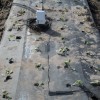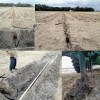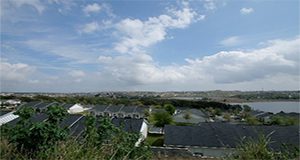Effective irrigation scheduling enables the irrigator to apply the right amount of water at the right time to meet the crop water demand. This 19-page guide presents information on average daily and weekly crop water use and crop growth stages for twelve north Florida crops that can be used to help schedule irrigation. This will allow a grower to develop a realistic irrigation schedule that minimizes plant water stress, saves water, and reduces nutrient leaching potential. Written by Vivek Sharma, Charles Barrett, De Broughton, and Thomas Obreza, and published by the UF/IFAS Department of Soil and Water Sciences, revised December 2020.
https://edis.ifas.ufl.edu/ss491
Tag: Charles Barrett
A Brief Summary of the Water Bill, SB 552
This 5-page document written by Lisa Krimsky, Andrea Albertin, Charles Barrett, James Fletcher, and Mary Lusk and published by the UF/IFAS Program in Fisheries and Aquatic Sciences of the School of Forest Resources and Conservation is intended to act as a quick reference guide and is not inclusive of all measures in SB 552. This summary addresses the Florida Springs and Aquifer Protection Act, the Central Florida Water Initiative, Northern Everglades and Estuaries Protection, and Pilot Programs for Alternative Water Supply.
http://edis.ifas.ufl.edu/fa205
Converting from seepage irrigation to plasticulture for vegetable production: a case study and on-farm demonstration
 Cabbage production in Florida has been dominated by the use of seepage or sub-irrigation, because it is inexpensive to maintain and simple to use, but it can require vast quantities of water to be pumped from the aquifer in low rainfall years. Plasticulture has been proposed as an alternative production method for cabbage production in Florida. An on-farm demonstration was setup on Greene’s Farms in Bunnell, FL to provide a platform for collaboration between researchers, growers and extension professionals. This 6-page fact sheet illustrates an innovative approach converting from seepage irrigation to plasticulture and points out some options and challenges for growers considering a plasticulture system. Written by Charles E. Barrett, Lincoln Zotarelli, Brian S. Taylor, Lucas G. Paranhos, and Mark Warren, and published by the UF Department of Horticultural Sciences, July 2014.
Cabbage production in Florida has been dominated by the use of seepage or sub-irrigation, because it is inexpensive to maintain and simple to use, but it can require vast quantities of water to be pumped from the aquifer in low rainfall years. Plasticulture has been proposed as an alternative production method for cabbage production in Florida. An on-farm demonstration was setup on Greene’s Farms in Bunnell, FL to provide a platform for collaboration between researchers, growers and extension professionals. This 6-page fact sheet illustrates an innovative approach converting from seepage irrigation to plasticulture and points out some options and challenges for growers considering a plasticulture system. Written by Charles E. Barrett, Lincoln Zotarelli, Brian S. Taylor, Lucas G. Paranhos, and Mark Warren, and published by the UF Department of Horticultural Sciences, July 2014.
http://edis.ifas.ufl.edu/hs1246
Subsurface Drip Irrigation (SDI) for Enhanced Water Distribution: SDI – Seepage Hybrid System (HS1217)
 In terms of water use efficiency, the traditional seepage irrigation systems commonly used in areas with high water tables are one of the most inefficient methods of irrigation, though some irrigation management practices can contribute to better soil moisture uniformity. Subsurface drip irrigation systems apply water below the soil surface by microirrigation, improving the water distribution and time required to raise the water table for seepage irrigation. This 6-page fact sheet was written by Lincoln Zotarelli, Libby Rens, Charles Barrett, Daniel J. Cantliffe, Michael D. Dukes, Mark Clark, and Steven Lands, and published by the UF Department of Horticultural Sciences, March 2013.
In terms of water use efficiency, the traditional seepage irrigation systems commonly used in areas with high water tables are one of the most inefficient methods of irrigation, though some irrigation management practices can contribute to better soil moisture uniformity. Subsurface drip irrigation systems apply water below the soil surface by microirrigation, improving the water distribution and time required to raise the water table for seepage irrigation. This 6-page fact sheet was written by Lincoln Zotarelli, Libby Rens, Charles Barrett, Daniel J. Cantliffe, Michael D. Dukes, Mark Clark, and Steven Lands, and published by the UF Department of Horticultural Sciences, March 2013.
http://edis.ifas.ufl.edu/hs1217

